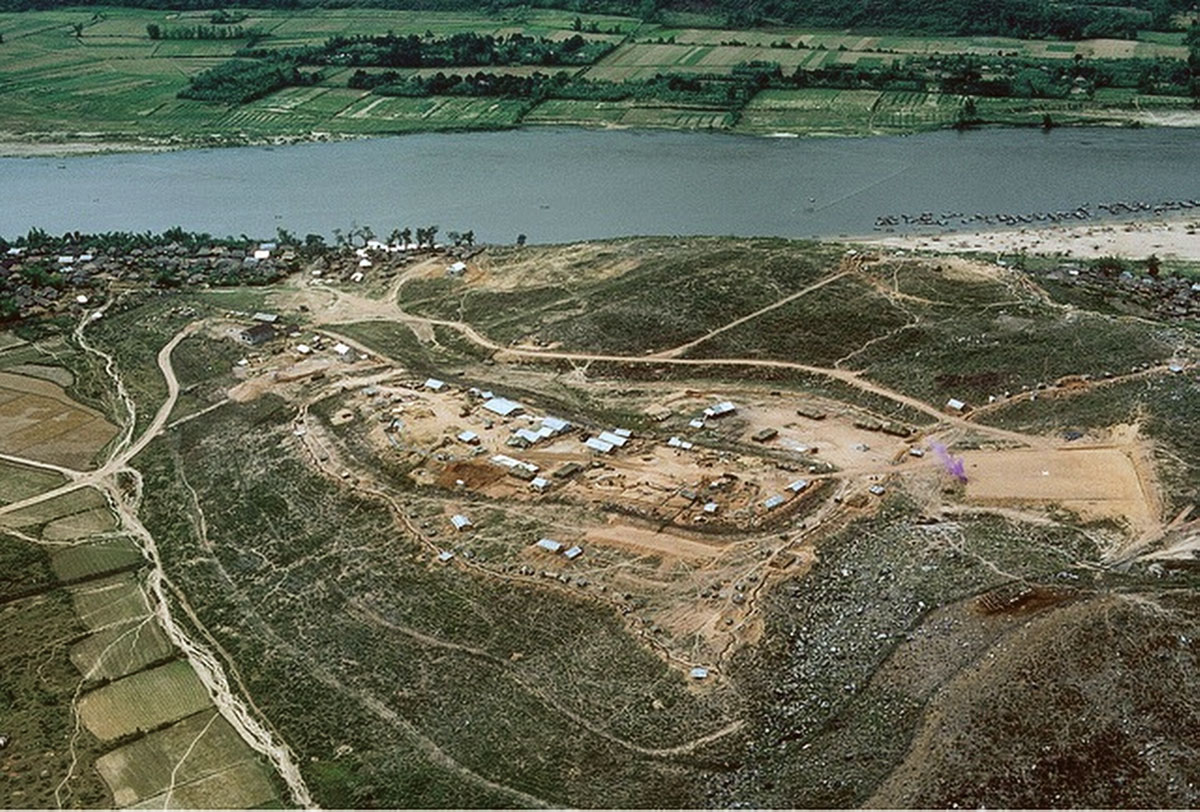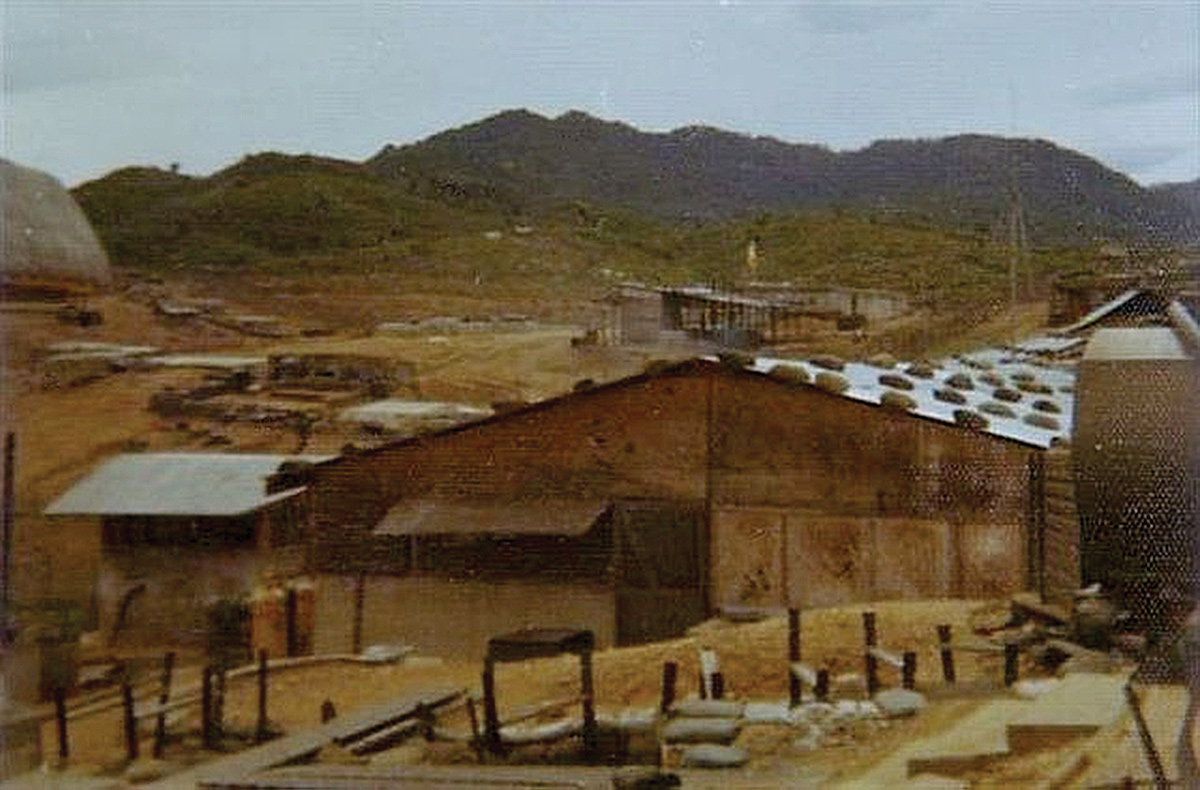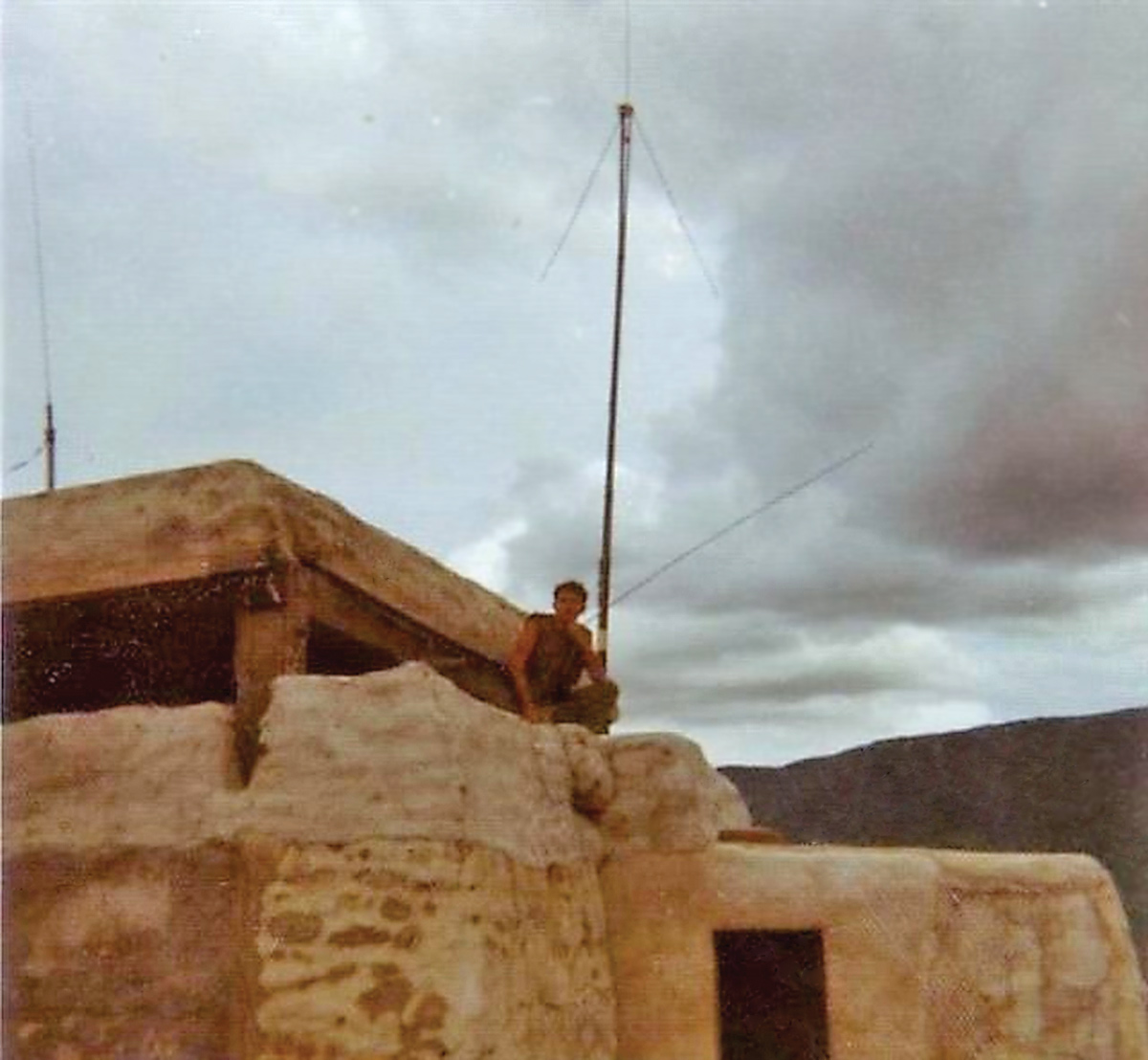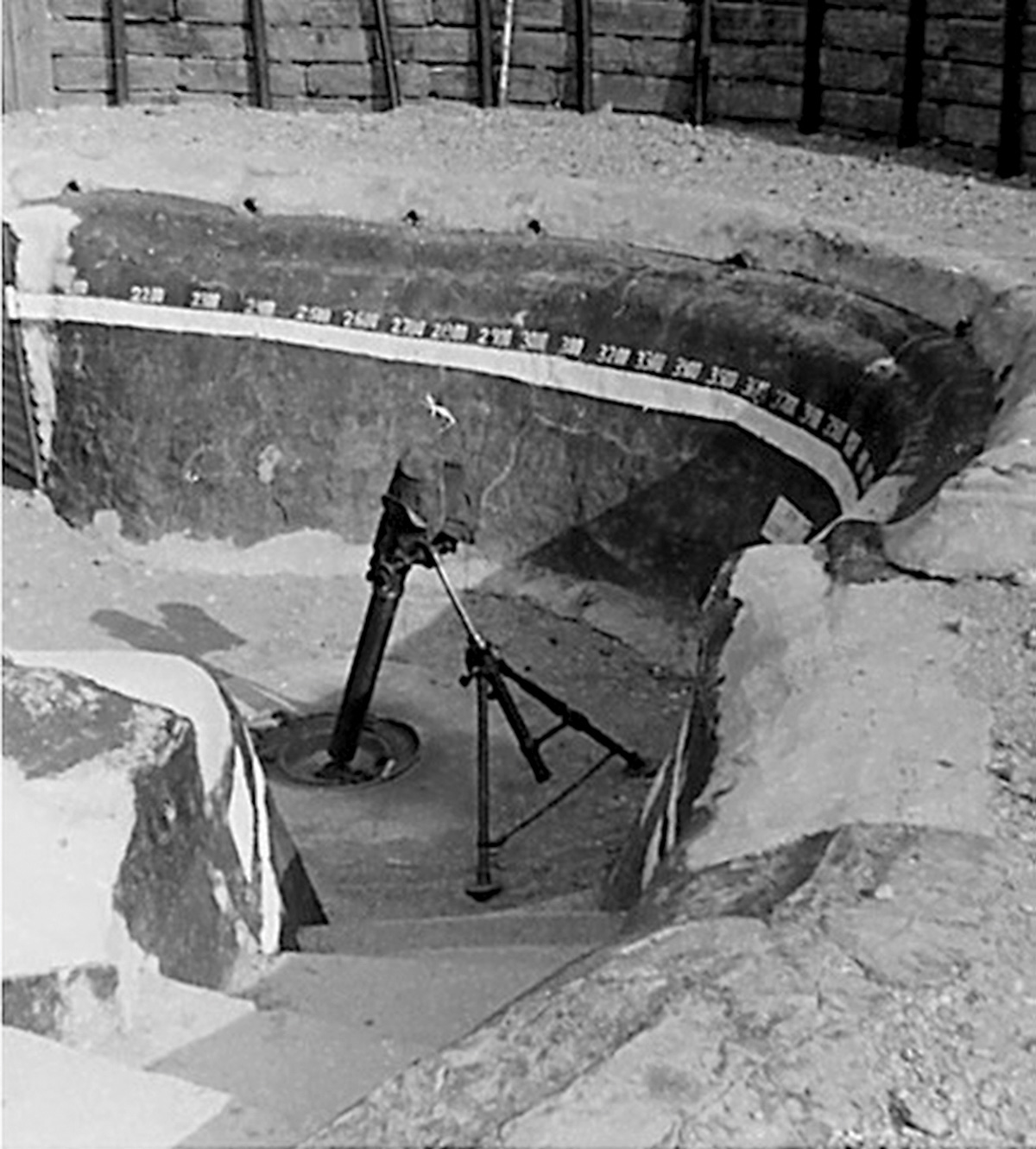The Siege of Thuong Duc
DET A-109
April thru June 1970


Aerial view of Special Forces Camp Thuong Duc, A-109, 1970. Purple smoke visible on helipad, right. Photo courtesy Jim Duffy
By CPT Jim Duffy, DET CO A-109 Thuong Duc
Originally published in the June 2015 Sentinel
A-109 Thuong Duc camp was in Quang Nam Province, South Vietnam. It was a spread-out area built to monitor and assess enemy activity that moved in to South Vietnam off of the Ho Chi Minh Trail Complex between the rural areas of the west and the more populated coastal plain in I Corps. The camp lay southwest of Da Nang and was placed there to help protect it from an attack from the west. Additionally, it was positioned in a key river valley that enabled its patrols to monitor critical enemy activity. It was the northernmost Special Forces A camp since the closing of A-101 Mai Loc.
The first night of the siege in April 1970 began with a well-orchestrated NVA attempt to overrun the camp. The initial assault began at approximately 4 a.m. and lasted several hours, severely testing the camp’s inner and outer defensive positions. Only through a strong reaction by A Team members and the indigenous troops, the NVA sappers were stopped about 200 meters from Duffy’s command bunker.
During this morning attack, the deadly claymore mines stopped the sappers dead in their tracks, which was a key turning point in that assault. I remember an NVA sapper Lieutenant who was cut in half amongst the dozens of other dead enemy soldiers laying on the ground. The advance was way too close for my taste. Fortunately, the camp perimeter multiple was reestablished after numerous attacks were neutralized.

A-109 Teamhouse. Photo courtesy Jim Duffy
When I went back to the C Team for a debriefing I was told that the intelligence officers knew ahead of time about the attack but had failed to tell me because they thought I “didn’t have the need to know.” Well, you can very well imagine how that conversation went. Two days later the 403rd SOD (including ASA men who spoke Vietnamese) arrived giving us much more intelligence. They did a fantastic job and definitely saved lots of lives in the camp throughout the rest of the siege with their timely reports and ability to listen to enemy soldiers planning the next attacks.
I was told by Gary Lamberty, of 5th Group’s 403rd SOD, that they had 44 men from ASA doing “Radio Research” along with a detachment of mostly SF qualified operators. Lamberty told me they used various electronic means to gather and disseminate intelligence to both the teams where we were located and to higher echelons. They frequently operated in two-man teams, which would go anywhere the 5th Group went, including the A Teams, Mike Forces, Special Projects, and at SOG radio relays sites along the border.
They also suffered through the attacks on A-109 where an estimated 4000 incoming rounds hit the camp, of which about a thousand hit the first several days. The 122mm rockets were by far the scariest. Thankfully, concreted bunkers and a deep trench system offered good protection and saved lives. One estimate during the siege was that 25,000 NVA troops were in Thuong Duc’s area of operation. Other estimates put them at over 10,000 troops, which included a battalion of sappers and a rocket battalion.

A-109 Teamhouse. Photo courtesy Jim Duffy
Ron Huegel was a corporal in the Marine Corps serving as a Field Radio Operator (MOS 2531) with 1st Force Reconnaissance which was concentrating its reconnaissance assets mostly to the west and southwest of Da Nang. He manned a radio relay site inside A-109 for the Marine recon elements in the field. Huegel and Marine Cpl. Phil “Flip” Clark rotated duty at the 1st Force Recon area called “South Fifty.”
Huegel told me that the camp received a volley of at least six 122mm rockets three times a day, in addition to harassment fire from 82 mm mortars fired from a plateau across the river from the camp, and from multiple other areas, and B-40 RPG’s and recoilless rifle fire at various times throughout the day. On 3 June the enemy scored a direct hit on his bunker. Ron told me that he and Flip escaped with only minor scratches and a loud ringing in their ears because the bunkers had been well built by American SeaBees – the best in the business of bunker construction.
At that time A-109 was a first priority for Tactical Air and Marine Artillery support in I Corps. For example, when our intel told us that an NVA Battalion was massed for an assault on our camp, we were able to plan for the attack. At one time there were 12 air strikes waiting to come in. Many C-119 “SPOOKY” and C-130 “SPECTRE” missions surprised a few NVA units with the 20 – 37 mm red dragon fire.
That NVA battalion was devastated, virtually wiped out. However, the siege didn’t end.
Meanwhile, multiple C-123, C-130 and CV-2 Caribou LOLEX missions provided necessary food and ammo to A-109. The trick was to recover the contents without getting killed. Fortunately, despite a number of attempts everyone escaped injury. Incoming choppers had 10 seconds to land and take off on a designated bunker to avoid incoming fire.

LTC Jim Duffy, then Captain of Special Forces A Team, A-109, Vietnam
During the spring 1970 siege, the camp was repeatedly receiving NVA 82 mm mortar fire from the plateau. I spoke with Dai Uy Diep, my SF Vietnamese counterpart, about sending a force up there to try and stop it. I advised him that it would have to be an entirely Vietnamese operation as all members of the American team had been going 24/7 and needed some recovery time.
He agreed and ordered a CIDG recon platoon up to the plateau. We monitored the operation closely and provided fire support as needed to cover their retreat. As I recall, the recon platoon, despite being outnumbered, inflicted heavy NVA casualties and damage to the mortars while returning unscathed. This is just one example of the courage, skill and determination of the indigenous troops who served with us at A-109.
As I write this report, some of the events remain vivid in my mind, because while it’s been 45 years, some aspects of that two-month siege have faded from my memory. But here are a few snippets that I remember:
- An 82mm mortar hit our team house with several of us inside;
- Our outhouse was hit by an errant eight-inch artillery shell;
- A Seabee was killed by an 82mm mortar round;
- During one of the frontal assaults that included artillery and rocket fire into the camp, I remember a 75 recoilless rifle round just missing my head as I was ducking for cover and hitting the ground — I can still hear that round today whizzing past my head;
- The multiple ground attacks seemed endless.
And during the siege the NVA pulled some psy ops on us. For example an English-speaking NVA troop came up on our FM radio frequency using our call sign and said, “Tonight you die.” Fortunately, he was wrong.
It’s funny now, but one night during a break in the action I fell asleep on top of a case of TNT wired with a timed detonator. Fortunately, it wasn’t my time to go. On another occasion, the NVA were again hammering our perimeter and the FAC couldn’t pick up where we needed Tac Air to direct its ordinance against the NVA, so I fired an M-79 flare round into the NVA. The FAC pilot followed that flare with gun runs that blunted another horrific attack by the NVA.
And there were strange circumstances too, such as how I used an American early version of the ‘night sniper rifle’, a Remington rifle equipped with a Starlight Scope, on several occasions to eliminate NVA during assaults on the camp. At the time this was the most technically advanced piece of sniper equipment available to Special Forces.

Thuong Duc mortar pit. – 81mm Mortar. Photo courtesy Jim Duffy
As any combat soldier will tell you, there were comical moments during the siege also:
One of my funniest memories during the siege occurred when everyone was sleep deprived. I decided to catch up on some sleep but remained fully dressed and ready to go. I was lying on my bed in the bunker I shared with Intel Sergeant Gerald Blais and I had just thrown a blanket over me when I heard something and saw an outline of someone standing over me. As I was ready to draw my pistol, there was a strange sound and I quickly realized that Blais was standing there just finishing up pissing on me. He buttoned up, turned around and went back to his bunk without a word. He had been sleep walking and got up to go the bathroom. I never said anything to Blais but Ski (Team Sergeant Gerald Adamski) and I had a big laugh about it.
On another night my counterpart’s German Shepard bit me in the leg.
Finally, around June 30 I mentioned to Ski that maybe, just maybe, we could look forward to packing our bags. The siege ended June 30, 1970 with one last round hitting the camp. Little did I know at the time that I would be leaving earlier than anticipated. I was suddenly medivaced after the siege, just as I was getting ready to request to extend my tour of duty in Vietnam and take an R & R to Australia. From the field hospital I went to Japan and later to Walter Reed. I spent the next year recovering from the almost deadly affects of staph septicemia that had been unknowingly been infecting me for several months due to a prior wound. Because I was so suddenly medivaced, many of the team members went years assuming that I died from wounds suffered in combat.
I had many positive experiences during my tour of duty at A-109. That assignment was the most rewarding personally and professionally out of my 23-year Army career. It was by far the best assignment in the U.S. Army to have the privilege to serve on a Detachment “A” team for any Special Forces soldier. The opportunity to serve with a team of American and Vietnamese professional soldiers under very challenging circumstances was truly unique. In retrospect, I remain awestruck by the required skills and depth of understanding it takes by everyone on the team to make the primary mission a success. The fact that all detachment team members survived the siege made that tour of duty by far the best memory of all.

Members of Special Forces A-Team, A-109, Captain Jim Duffy on left. Photo courtesy Jim Duffy
During the siege Detachment A-109 consisted of the following team members:
CPT Jim Duffy, Detachment CO; ILT John Wiegner, XO; 1LT Renard Marable, CAPO; MSGT Gerald Adamski, Team Sergeant; SFC Gerald Blais, Intel; SFC Ernie Russi, Commo Chief; SSGT David Cook, Heavy Weapons NCO; SGT Greg Biela, Weapons & CAPO NCO; SFC Henry Ray Smith, Medic; SGT Tim Harlan, DEMO/ENG; SGT Ken Hernasy, Asst Heavy Weapons; SP/4 John Runstrom, Commo;
I would be remiss not to mention my counterpart Dai UY Diep. He was exceptional in his leadership, knowledge, wise counsel, loyalty and courage. It was an honor to serve with him.
This article is dedicated to Detachment A-109, U.S. Army Special Forces and Vietnamese Special Forces members, as well as the camp CIDG (Civilian Irregular Defense Group) soldiers and our interpreters. Likewise, the 1st Mobile Strike Force, B-55 Mike Force, the 1st Force Recon, 403rd SOD, U.S. Air Force pilots, Marine Corps and Navy aviators, and the Seabees. All served with such great skill, honor, loyalty and courage.
Sadly, in August 1974 Thuong Duc fell and defending South Vietnamese troops were massacred and overrun by NVA forces.
Editor’s Note, courtesy of John S. Meyer. “During the SFA Reunion in Orlando in 2011, I shared an amazing moment with Jim Duffy. He was talking to former A-109 team member Greg Biela, recounting how in 2005, Biela approached Duffy for the first time since 1970 and said, ‘You’re dead,” assuming that Duffy had died from combat wounds inflicted before and during the siege. He was detailing how amazed and happy he was that Duffy was still above terra firma. As Biela told the story, a Mike Force Green Beret who fought during that battle, approached Duffy with shock and amazement in his voice and eyes: “You’re alive. We (team members from A-109) all thought you died.’ Duffy and Biela assured the Mike Force troop that Duffy was still alive and well.
About the Author:
Jim Duffy, LTC U.S. Army (Retired) Special Forces, served for twenty-three years in Korea, Vietnam, Germany, Taiwan, and Hong Kong. He is a Legacy Life Member of the Special Forces Association (SFA) and past-president of SFA Chapter 78 (2007-2009). He is currently a highly regarded instructor at Artemis Defense Institute. Read Jim’s Member Profile to learn more.

My 4-gun 155mm Battery (Delta-Xray) 2nd Bn, 11th Marines provided fire support to Thung Duc during April and May 1970. J.W. Vagnetti
I was a crew chief on a CH-53 Helicopter, from HMH-463 out of Marble Mountain, by DaNang. I remember lying on my stomach looking through the hell hole with a load of ammunition for your camp. We were dash 3, and in between each load of 1 and 2, we could see the impact of mortars on the runway. They sent us as the Army’s 47’s were to slow. Thanks for a great party.
LTC Duffy,
Hello Sir, my name is Dana Zuber. I was a Marine corporal in 1969 with 1st Force and 1st Recon BN.
I was at camp 109 for the 63 day siege at Thoung Duc in May till June, in 1970.
I ran across this most amazing story just today.
It brought back so many memories
And After the first night attack I was standing next to you that morning when we saw the bodies strung out in the wire.
I asked you if we were going to remove the bodies and you said “no, they’ll be back tonight”, or something to that effect.
That remark was chiseled in my mind forever.
I was one of two Marines in the camp as a radio relay operator for our Recon teams in the area.
It was amazing to read this story but also amazing to not see my name in the piece although I was involved as much as the rest. I imagine no one could remember my name.
I’ve told the stories over and over to family and friends and I will admit reading this wonderful piece gave me a feeling of belonging and camaraderie but also a huge let down.
The other let down was after the 63 day battle, everyone received a Bronze Star except us 2 Marines. I was the last guy in that formation and wiatched the dignitaries pin medals on everyone but the two of us.
I got along with Ski very well and he wrote for me up for the Star but apparently it didn’t fly .
It’s been 55 years and I’ve always wondered why, since we fought the same battle and chewed on the same dirt.
I was honored to go on Patrol with one of the, teams, maybe you remember we captured that old piece of war tech on wheels.
Also I was on the LZ when the team got shot up and the Crew Chief was killed and the crew was shot up too.
I also remember our resupply from the C130 drop.
That stuff was real, never forgot that.
When I was in Bravo company 3rd herd 1st Recon
We ran patrols off Thoung Duc more than once.
I remember Mamason and the knuck mom.(sp).soup. And Chief drank only Budweiser lol.
I’ll have to dig up some pictures.
Oh and I was the guy who had the external load cut because I saw smoke coming from the load.
Turned out to be cement bags ripped open and giving the illusion of smoke. When they cut the load it hit the river bank and broke apart. Bad thing, yup the ration of beer and soda hit the shoreline. If I’m not mistaken the villagers were scarfing it up.
One more memory., we knew they were shooting gas at us but no one thought that to be factual. So either you or Sgt Ski sent me out and I found samples of CS gas.
And lastly, Carl Dee Wooten
He died on May 1st 1970.
He and I hit it off right away. Good guy, lousy basketball player but so were the rest of us.
We had that basketball game the night of April 30th
And he was dead the next day. I opened the body bag, he looked so peaceful .
Dana – Thank you for your comments regarding your experiences at Thuong Duc. It brought back memories of my time out there & put forth some info that I was not ever privvy to. For example, the name of the Seabee that was killed out there. I was sent out there during the seige without a flak jacket & they gave me his jacket. I was a Special Forces medic & mortar man & all I can recall is that I spent most or all of my time in the mortar pit; awake at night firing off mortars & sleeping during the day. So sorry to hear that you weren’t awarded any medals for your efforts out there; you certainly deserved one for all that you did!!
I was with the 4th infantry. Myself Larry Puckett spec4 and lieutenant were sent there for radio support. We stayed in the command bunker. Just wanted to add this as this was very definitely an experience to never have been forgotten